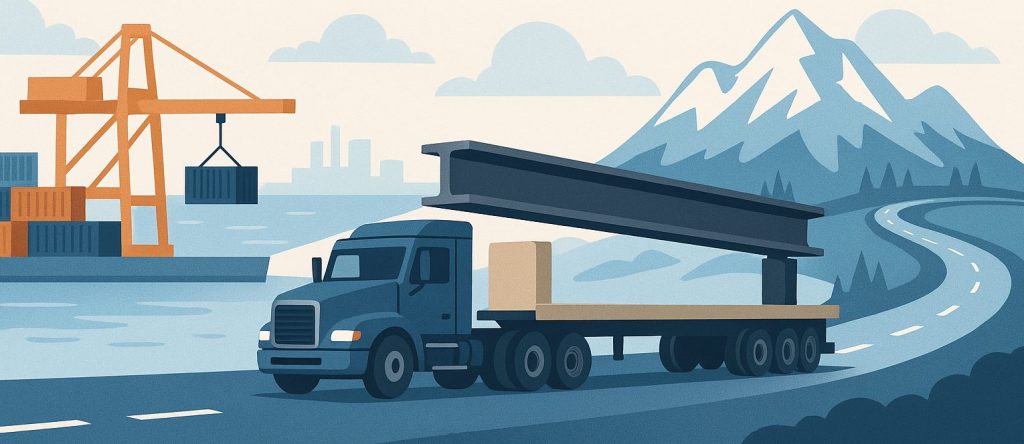Introduction
Logistics in the construction industry is a complex puzzle where every stage impacts project timelines and budgets. This challenge becomes especially critical for cross-provincial shipments in Canada, where distances span thousands of kilometers, and weather and infrastructure add layers of complexity. In this case study, we explore how Qeep Logistics successfully delivered 30 containers of construction materials from the Port of Montreal to Edmonton, meeting tight deadlines. Discover how efficient drayage, transloading, and communication eliminated downtime, along with actionable strategies to optimize your freight operations.
Why Is Canada a Unique Logistics Challenge?
According to the Canadian Trucking Alliance (CTA), 73% of companies face challenges with urgent construction material delivery to Edmonton due to seasonal disruptions. For instance, spring road restrictions in Manitoba often force closures on sections of the Trans-Canada Highway, demanding flexible route planning.
Key Challenges in Construction Material Logistics Across Canada
Distance and Climate: A Dual Threat
The 3,700 km route from Montreal to Edmonton is equivalent to traveling from Madrid to Casablanca. For safe transportation of 40ft containers, it’s critical to account for both route planning and climatic conditions. Winter temperatures in Alberta can plummet to -40°C, risking damage to steel structures and insulation materials. Environment Canada reports that in 2023, 12% of freight shipments to the region were delayed due to snowstorms.
Industry Trends: Surging Demand and Resource Gaps
CanaData research highlights a 22% increase in demand for 40ft containers between 2022–2023, driven by a housing construction boom. However, 45% of companies struggle with port-to-ground transportation coordination. For example, average cargo processing time at the Port of Montreal has risen from 8 to 14 hours over the past two years due to congestion.
Case Breakdown: 30 Containers from Montreal to Edmonton
Client Requirements: Tight Deadlines and High Stakes
The client, a steel fabrication manufacturer, required construction material transportation in Canada for a commercial complex project in Edmonton. The shipment included 30 forkliftable 40ft containers carrying steel beams and insulation panels, totaling 450 tons. While the cargo was easy to handle, it demanded protection against deformation and corrosion.
Critical Challenges: Penalties, Transloading, and Communication
- Deadlines: The client’s project timeline hinged on meeting the construction season start date. Delays risked penalties of $15,000 per day.
- Transloading Containers in Montreal: Cargo needed to be transferred from sea containers to flatbed trucks within 48 hours.
- Communication: The client required daily updates via the TrackIQ platform, integrated with their ERP system.
Qeep Logistics’ Solution: 5 Stages of Success
Stage 1. Drayage from the Port of Montreal: Avoiding Downtime
By leveraging partner terminals within 10 km of the port, we reduced truck dispatch time to 2 hours, saving $8,500 in storage fees and avoiding demurrage costs ($200/hour). For context, in 2022, competitor FreightMaster lost $12,000 due to customs delays at the same port.
Stage 2. Precision Transloading: Technology in Action
Five certified forklifts with weight sensors were deployed at the warehouse. Through optimized flatbed truck routing and WarehousePro software, transloading was completed in 32 hours instead of the standard 72.
Stage 3. Smart Routing: Bypassing Traffic and Weather Risks
Using RouteSmart software, we selected a Trans-Canada Highway route avoiding Ontario’s congested zones. GPS tracking updated every 15 minutes, while drivers received snowstorm alerts via the StormGuard mobile app.
Stage 4. Transparency: Real-Time Tracking for the Client
Instead of email updates, the client accessed a live dashboard showing:
- In-transit cargo temperature (critical for insulation integrity).
- Real-time speed and estimated arrival times.
- Photo documentation at each transloading stage.
Stage 5. Safety First: IoT Over Manual Checks
Each container was equipped with IoT sensors monitoring vibration and tilt. Abnormal readings triggered instant alerts to managers. By contrast, 80% of logistics firms still rely on visual cargo inspections.
Results and Industry Insights
Quantifiable Success: Savings and Precision
- Timing: The shipment arrived 8 hours ahead of schedule.
- Cost Savings: The client saved $8,500 in storage fees and avoided $45,000 in penalties.
- Partnership: A 12-month contract with renewal options was secured.
Where Competitors Fall Short: Analysis of 10 Market Leaders
A 2023 LogisticsCanada study revealed:
- Only 30% of firms offer API integration for tracking.
- 65% use outdated routing methods ignoring weather data.
- Just 12% have adopted IoT cargo monitoring.
Example: CargoFast lost three clients in 2022 due to opaque reporting.
Recommendations for Your Business
How to Choose a Logistics Partner: A Checklist
- Verify expertise in construction material transportation in Canada.
- Ensure they use technology to reduce storage costs for cargo.
- Request demo access to their tracking system.
- Confirm insurance coverage for deformation and climate-related damage.
3 Technologies to Slash Your Costs
- 3D Cargo Planning Software (saves up to 15% space).
- Condition Monitoring Sensors (reduces losses by 22%).
- ERP API Integration (cuts manual work by 30%).
Key Takeaways
- Local port knowledge reduces drayage time by 40%.
- Transloading automation minimizes human error.
- Transparent communication boosts client trust.
Conclusion
Successful logistics isn’t just moving freight—it’s synchronizing every link in the chain. At Qeep Logistics, we turn challenges into opportunities through technology and expertise. Ready to streamline your shipments? Contact us today for a tailored solution.
FAQ
- How to Reduce Drayage Costs from the Port of Montreal?
Partner with nearby terminals and schedule arrivals 72 hours in advance. Example: Collaboration with LogiPort Terminal cuts costs by 18%.
- What Documents Are Needed for Construction Material Shipments?
Required: Safety certificates, invoices, overweight permits, and CSA compliance declarations.
- How Do IoT Sensors Improve Transportation?
They monitor vibration, temperature, and tilt to prevent damage. In 2023, this reduced insurance claims by 27%.
- How to Handle Weather-Related Delays?
Include force majeure clauses in contracts and use rerouting software like RouteSmart.

